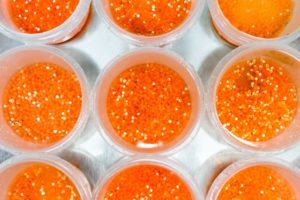WP1 Genomic Innovations: Enabling commercial-scale genomic selection
Wageningen University. WP Leader: John Bastiaansen.
Data collection in commercial environments is an important activity for the first year of WP1. Families have been produced for trout, salmon and parental fish have been selected to produce sea bass and sea bream families later this year. Many of these fish will be genotyped to show the impact and opportunities of genomic selection for health, quality, and growth traits under fish farming conditions. In addition, both

genotype data as well as current breeding program data are provided by industry partners for the work on design of practical data structures and strategic genotyping designs for genomic selection. Methods and equipment for phenotyping are in development with schematics for automated phenotyping being discussed among partners. These actions will eventually aid in the implementation of genomic selection with cost effective phenotyping, genotyping and sampling designs that are tested with industry partners and in the commercial environment.
WP2. Nutritional Innovations: Precision Nutrition for Superior Genotypes
University of Las Palmas de Gran Canaria. WP Leader: Daniel Montero.
During the first year of the project, formulation of the tailored diets is one of the main tasks, together with the production of the families of the different species. The produced genotypes (selected vs. unselected) will be challenged either with a “future diet” or a commercial diet during the on-growing period.
For marine species, the formulation of future diet (a tailored feed) has been done for European seabass and gilthead seabream based on the utilization of novel ingredients and raw materials in low fish meal and low fish oil diets. The selected families have been produced for gilthead seabream (families with high and low genetic potential) and are growing within ULPGC facilities. The selected families of European seabass (selected vs. unselected males) were produced at IFREMER and travelled to Canary Islands, and are growing within ULPGC facilities.
For salmonids, the future diet for rainbow trout has been defined based on the strategy mentioned above and will be produced by INRA. The fish with long selection history and their control population have been produced at Aqualande facilities. For Atlantic salmon, high and low pigment groups have been produced by Mowi. Diets formulations are being planned in terms of sustainability of the ingredients for a future diet.
The use of the tailored diets for superior genotypes originating from breeding programs will enable the genotypes to express their full genetic potential to improve commercial production efficiency.
WP3 Impact on industry profit, environmental, and investing in future
Akvaforsk Genetics Center AS, WP Leader: Morten Rye.
Multi-generational data from applied breeding programmes are currently being organized and analysed for documentation of achieved genetics changes for key fish traits. This work will be followed by additional modelling and analyses to assess the economic and environmental impact of selection and facilitates derivation of precise economic values for individual traits for the programs involved. Derivation of economic values is planned in collaboration with the partner companies. These actions will eventually quantify realised progress and achievements in on-going applied breeding and feed development programmes, and suggest new ways to improve both.
